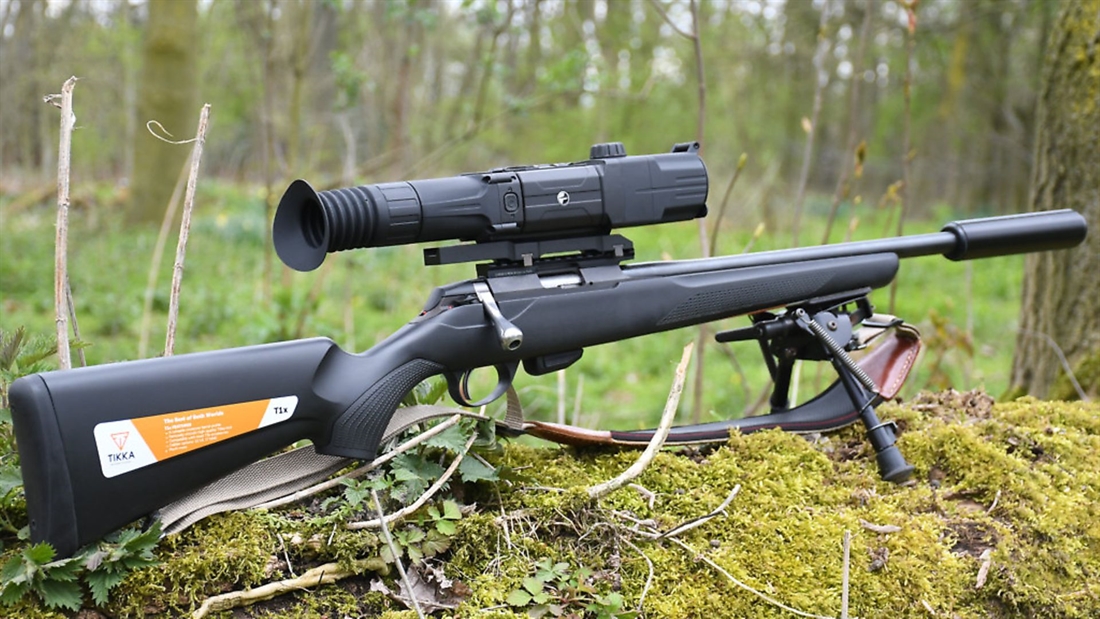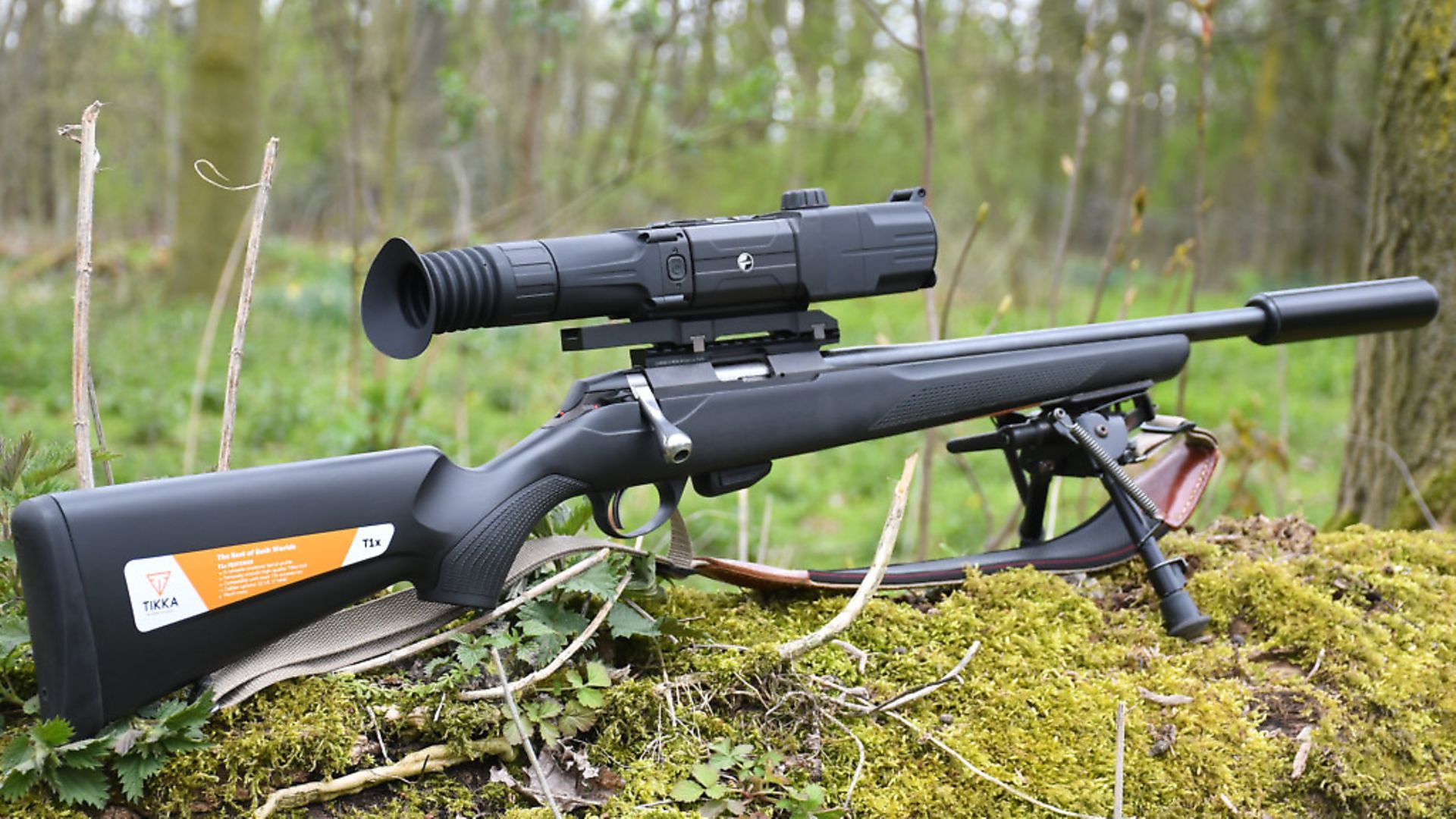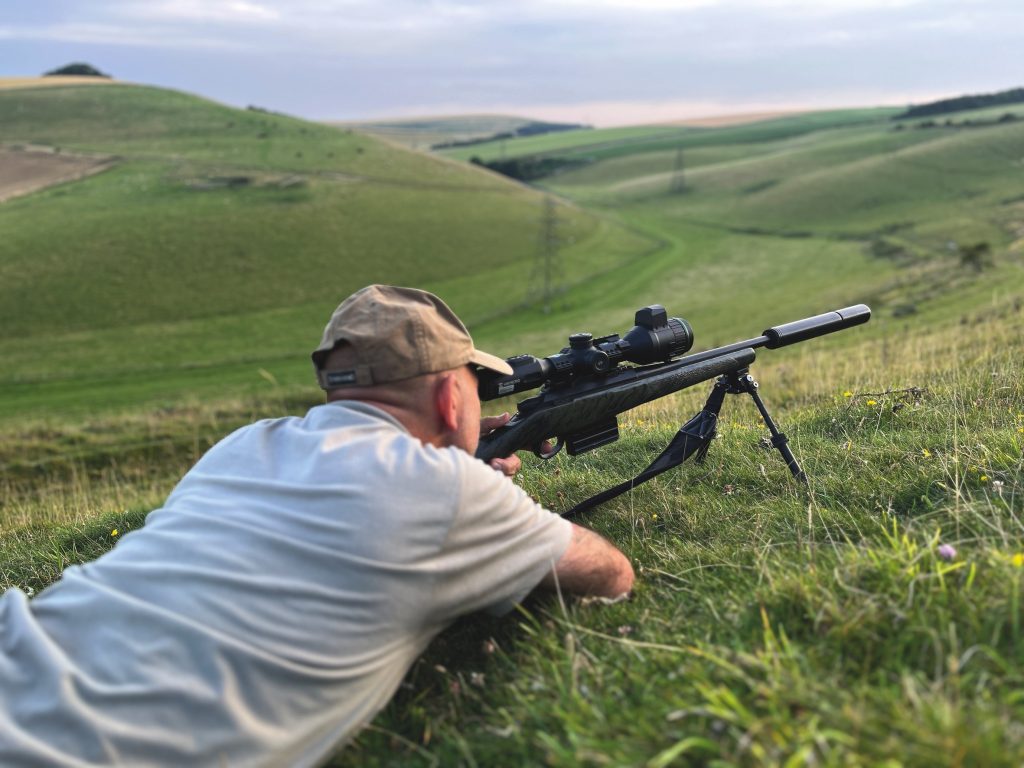Pulsar Digisight Ultra N455 HD Digital Night Vision Riflescope – tried & tested

Chris Parkin puts the Pulsar Digisight N455 HD Digital NV rifle scope to the test to see what benefits the updated model provides for serious pest controllers
OVERVIEW – Pulsar Digisight Ultra N455 HD Digital Night Vision Riflescope
FOR: Improved display characteristics; Effective battery system; New aperture size is a better compromise; Tactile buttons with Picture-in-Picture capability; 10 stored zeroing distances overcomes previous adjustability concerns
AGAINST: Box shape still leads to high mounting and head up position; Alternate mounting point for extra illuminator on the side is problematic; Incorporated illuminator provides little assistance
VERDICT: The image quality has been improved, but it still relies on an external 850nm illuminator to boost performance. The included 940nm unit is good out to airgun ranges, but with the Wicked Light added on for larger calibres it provides the perfect daylight/night optic for serious rabbit control and foxing
TECH SPECS
Sensor Type: CMOS Sensor
Camera Resolution: 1,280×720
Display Type: AMOLED 1,024×768
Video Out: Wi-Fi Transmission
USB Type: Micro USB
Capacity: Built in video recording 8gb capacity
Magnification: 4.5x to 18x
Relative Aperture: 1:1.2
Digital Zoom: 2x-4x
Close Up Range: 5m
Eye Relief: 50mm
Exit Pupil: 5mm
IR Illuminator: LED 940nm
Range of Detection: 500m
Shock Resistance: 6000 J for use up to .375
Dimensions: 370x73x74
Includes standard weaver rail – QD112 quick release rail available as additional extra
RRPs: £1,199.95; £1,295.95 including the Wicked Light A51IR and adjustable mount
CONTACT: Scott Country 01556 503587
ALSO USED:
Tikka T1x in 17 HMR GMK 01489 579999
Hornady 17 HMR ammunition Edgar Brothers 01624 613177
Tier-One Monolyth sound moderator Tier-One 01924 404312
Britannia Picatinny Scope rail Country Sports Wholesale 01462 743223
IN DEPTH REVIEW – Pulsar Digisight Ultra N455 HD Digital Night Vision Riflescope
The latest Pulsar N455 HD Digisight Ultra is a step up from the N355, mainly offering improved image quality for digital night vision users looking to maximise capability. Subtle tweaks include a slight redesign of the ocular end of the scope, with a more swooping extension towards the ribbed, rubber-cupped eyepiece shield.
The main external technical changes are a larger 10mm aperture on the flip-down objective lens cover, and a new left-side illuminator on a quick-release lever that covers a Weaver mount. Users of the previous N355 found the pinhole aperture great in daylight with its improved depth-of-field and minimised light entry, but when darkness fell and the unit needed to excel, opening the flip-up lens cap to expose the objective lens could potentially allow too much over-spilling light to dazzle the image. Some fair attempts were made at remedying this with either drilled out lens caps or slot-in add-ons, but now Pulsar have addressed it with a 10mm aperture lens giving a much better compromise under artificial added IR illumination.
The excellent IPS5 battery and charger are still pivotal in the specification, with a decent eight-hour runtime depending on how much on-board illuminator power you use; that in itself, with invisible 940nm light, is quickly removable entirely. It’s mounted to the left side of the body, where it covers the underlying Weaver-type block for aftermarket add-ons.
A Weaver mount is supplied to bolt underneath the N455, with four possible anchor points that allow varied eye relief to be set up when fitting on your rifle, which is far easier to do with a full rail than with individual bases. The claws tighten with a 14mm socket or spanner and, although bulkier than Allen or Torx, they will give good return to zero when swapping between conditions and seasons if applied with a torque wrench to about 3 or 4Nm.
Eye relief within the concertinaed rubber eye tube is 50mm; that’s fine with smaller .224 or .243 centrefires, but with a suggested capability of withstanding .375 Magnum, rather you than I putting that rifle so close to my eye!
On the other hand, the 5mm exit pupil is acceptable, although the focal point of the lens is again almost pinprick-sized, with not much eye box to drift around in to retain sight picture on target between shooting positions or through recoil. The generally high mounting position necessitated by the scope seems to encourage a face/eye facing square up to the Digisight, more likely from standing, seated or leaning shooting positions, rather than prone. After spending many hours behind it for the last three weeks, I can definitely feel my neck dissuading prone operation!
Turning the unit on with a brief press of the rear right side button springs it to life in a few seconds, at base level 4.5x magnification. The battery has a quick-release lever and, if you carry a spare, is easy to swap over in darkness without fuss. The four top menu buttons are similar to the rest of the Pulsar range and require short or long presses to divulge their dual functions – Up, Menu, Down, Camera, in that order from front to back. Scrolling through the menu while following the instruction book is straightforward; it is worth spending a few minutes on it before you mount the scope, as it will be easier to familiarise yourself with the button press sequences with it held to your eye and the other hand holding the manual.
The scope can be mounted to five different rifles, each with up to 10 different distances zeroed into the memory, which can be quickly accessed and flipped between when actually out hunting. A quick press to the menu button brings up the primary options for immediate use, with brightness, contrast, magnification, Stadiametric rangefinder and required shooting distance, which you may or may not have individually programmed beforehand. If you are a ‘dialler for distance’, I strongly suggest you use all the available distance slots far in advance of needing them, because entering the full menu screen under pressure in a hurry is not advisable, and adding individual clicks is not realistic.
The full secondary menu requires a longer hold of the menu button on top and allows the major set-up functions to be accessed. These are for zeroing, wifi, general time/date set-up, your video set-up, and connection to a smartphone or tablet to live-stream video through the similarly named StreamVision app. Ten reticle choices are available with various levels of simplicity or complication and aim-over hash marks, as well as slim designs or bulkier offerings depending on the likely game you are going to hunt.
There are also nine colour choices for your preferred contrast on the image within, and the reticle brightness itself also has 10 levels to choose from. When zeroing, the moving reticle image is the alternate choice to the moving image system seen on most conventional daytime optics, so read the manual and don’t try to double guess yourself.
I’d recommend shooting in daylight at a large, well-defined, circular, black target on a white backer for the most definition. Use a spotting scope or binoculars, or simply walk forwards, to see your impacts as you are unlikely to see them through the scope itself (maybe a little on Shoot-N-C-type targets). Then the easiest thing to do is stick a second, obvious marker over that bullet hole and return to the rifle; this makes it far simpler to aim the rifle at the original target, and then move the projected X onto the point of impact before holding down the menu key to save the update. You can support the gun in a rest to keep things stationary, or a freeze frame option is available to do this with more ease, which works fine.
Winding the magnification up and down when zeroing to make the target easier to see is possible if necessary, and my one recommendation would be to forget about counting clicks. Concentrate on the reticle movement and make notes of the displayed X and Y axis figures. When altering magnification in the zeroing menu, at 4.5x magnification each click is worth 1 (i.e. 3.00 goes to 4). If you set 18x magnification at this stage, clicks are now worth 0.25 of a click; if you use 9x mag, each click is worth 0.5, or half a click. This works ok, just be sure that you pay attention to all the decimal places and you will get a precise zero.
Forget anything you ever leaned about MOA or Milliradians directly as they no longer apply exactly here. It’s all down to the pixel resolution available from the image screen inside the scope. Learn all this in the comfort of an armchair as, when bolted to the rifle, every extra moment you spend scrunched into the shooting position with your hand atop the scope is a physical strain and will be frustrating.
I set the scope up on a trusted Tikka T1x in .17 HMR with a Britannia Weaver rail added to it as I wanted a well-known gun to form the foundation of my test. Set-up was straightforward, and a trip out rabbiting led me to my first defined opinion – given the capability of a .17 HMR out to, say, 150m, the Digisight with the on-board illuminator was a little disappointing for me initially.
940nm IR has the benefit of being invisible but has nothing like the reach of 850nm, so rabbits hunkered in 3-4″ crop were invisible beyond 50m; there wasn’t any eye shine at all. Unclipping the illuminator reveals a Weaver block to attach an aftermarket unit with a bit more oomph, and Scott Country is offering the Wicked A51IR hunting light in a package deal, which I would highly recommend obtaining. This light has a quick-release lever to latch it onto the scope, and visible red 940 and 850nm IR light capability at the flick of a switch; its adjustable mount is capable of fine zeroing adjustment and can be locked into position.
The ability to lock the mount helps with the fact that this is a fair chunk mounted on the left side of the Digisight which, although not particularly heavy, requires a bit more delicacy when handled onto rests and shooting sticks, or slung on your shoulder while walking.
The capability on rabbits is now opened up significantly, with distinctive eye shine peeping above the developing crops and better recognition of body shape and aim point. Day shots of over 250m are now possible on unobscured rabbits and pigeons, but realistically, head shots are more likely to be 75-100m due to the 4.5x optical magnification that is all boosted digitally, with consequent pixilation to the precise shape. For foxes, it does give far better aiming precision on the physically large body and it’s really about the illuminator now. Foxes can see the 850nm but they aren’t all savvy to what it is yet… so don’t give them a lesson by missing or wounding!
Importantly, the Pulsar gives you everything a thermal scope won’t, with far more definition of crops, foliage and obstructions to the bullet’s path, and I am utterly convinced that digital night vision coupled with thermal spotting capability is the most effective and safe nighttime armoury these days – the best of both sensory worlds at the right time and cost.
Improvements of the N455 over the 355 to me were most obvious in daylight conditions, with the 10mm aperture giving a better balance between the two. Focusing is still controlled by the small knurled dial above the objective (probably the best spot for an illuminator mount), although that side-mounted illuminator is often in the way, and I tend to focus at 100m before leaving things alone.
Generally, I will have time to make alterations and, in daylight, the smaller aperture is excellent for focusing a clear picture with a fine reticle. Dusk is always the crossover where digital NV has a slight hiccup where you used to appreciate image contrast and colouration to pick up small game, and now rely solely on movement to draw your eye without eye shine from the IR. Yet that improved image on the 455 has taken another step in defining the shapes in the black and white world, which is becoming less of a strain on the eyes with more familiarity every time I use it.
The picture-in-picture is an excellent piece of electronic capability, not so much for identification but for better shot placement without sacrificing any field of view; the button presses seem more tactile too. I can see this retaining the premium digital NV market share for some time to come, although I do think the next step needs to address some of the mounting height and external illuminator position issues.
An N450 version is also available with an 850nm IR illuminator frequency for a bit more reach, but I’d be tempted to add a Wicked Light anyway as their performance is a considerable improvement over any smaller on-board IR unit; it’s a good move from Scott Country to offer that package deal.
For serious rabbit control, I can’t really think of a better suited optic for daylight and night use in the long-term, with reliable battery performance in all temperatures and one that has proven itself to me on countless similarly shod Pulsar NV and thermal equipment. It’s far superior to multiple AA set-ups. When ratting with an airgun, FAC or sub-12 ft/lbs, the N450 would be my choice as that would be satisfactory at close ranges, perhaps even for .22 rimfire range hunting too. For .17 HMR or larger foxing calibres, though, don’t scrimp on the illuminator – the Wicked Light is worth its weight in gold, even if it is a little more bulky.
At time of review, this was the latest model, but the next set of firmware updates are likely to add sound recording and further colour modes.
Related Articles
Get the latest news delivered direct to your door
Subscribe to Rifle Shooter
Elevate your shooting experience with a subscription to Rifle Shooter magazine, the UK’s premier publication for dedicated rifle enthusiasts.
Whether you’re a seasoned shot or new to the sport, Rifle Shooter delivers expert insights, in-depth gear reviews and invaluable techniques to enhance your skills. Each bi-monthly issue brings you the latest in deer stalking, foxing, long-range shooting, and international hunting adventures, all crafted by leading experts from Britain and around the world.
By subscribing, you’ll not only save on the retail price but also gain exclusive access to £2 million Public Liability Insurance, covering recreational and professional use of shotguns, rifles, and airguns.
Don’t miss out on the opportunity to join a community of passionate shooters and stay at the forefront of rifle technology and technique.





